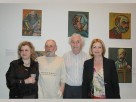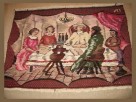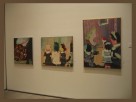Family Album: Jewish Artists from St. Petersburg
Event Venue:
The Laurie M. Tisch GalleryThe JCC in Manhattan
Event Date:
May 18, 2006 to July 13, 2006On View: May 18th - July 13th, 2006
(If you are interested in purchasing and/or viewing more artworks, please contact the curator Regina Khidekel at Khidart@aol.com or 646.831.0554)
Despite the ban for most of the twentieth century on any expression of Jewish life in the former Soviet Union, Jewish personal identity and artistic sensibility managed to survive and is now flourishing in modern Russia’s atmosphere of greater freedom.
The exhibition Family Album: Jewish Artists from St. Petersburg, features a group of Jewish artists from Russia, who address two important questions: How did Jews survive during soviet times and how are they surviving today? This exhibit gives voice to the belief that by remaining true to their roots, the Jewish people will always emerge from adversity with hope and their Jewish identity intact. By conveying their unique experience as Jews in Russia, these artists are sharing issues of cultural and ethnic tolerance through the universal language of art.
This artistic group, known as The Pgishot (Gatherings), includes Anatoly Zaslavsky, Robert Lotosh, Aron Zinshtein, Boris Borsh, Alla Pogorelskaya, Alla Davidova, as well as several other artists. These artists are united by their unique Leningrad schoolingand technique, close generational bonds, the common struggle for individual expression within the bureaucratic stiffness of the former Soviet Union, delayed recognition, and the late discovery of their ethnic roots.
Several years ago these artists began gathering together to explore their Jewish identity by studying Torah and Jewish texts. Since then, they have traveled to Israel for artistic exploration as well as to Jewish historical places in the former Pale Settlements. They often meet together to celebrate Jewish holidays, and have become an artistic reflection of the revival of Jewish life in Russia.
The Pgishot made its mark on the Russian art scene with the opening of an exhibition called The Creation and The Works in 2001, which showcased works based on their study of the Book of Genesis. Since 2001, The Pgishot has had annual exhibits in St. Petersburg and Israel. They have been able to translate their individual expression and perception of Jewishness into art ranging from painting and sculpture to artistic textual fusions.
While each of the artists has followed his or her individual path, the artistic group is united by the artists’ shared belief that the traditional practices of painting, sculpture, and craft have not been rendered obsolete by new media. Rather, these traditional practices remain a powerful vehicle for expression, utilizing both irony and playful eccentricity.
Based on the tradition of modernism in both Europe and Russia, and the presence of contemporary art movements, The Pgishot could be linked to a branch of St. Petersburg Neo-Expressionism. Its tradition of attentiveness to painterly culture and its approach to subject matter are influenced by an older generation of artists, in particular, Josef Zisman, whose paintings awaked a sense of Jewish sensibility. Although the meaning of Jewish art is still not concretely defined, the following characteristics could be attributed to it: warmth, enjoyment, the gratification of being, pantheistic animation and elevation of common objects, calm observance, and light sadness mixed with irony.
The works of The Pgishot can seem unintended, almost accidental and fortuitous. Portraits and cityscapes are the preferred genres because they focus on the flow of daily life, where artists mingle, work, and interact casually on the streets of the city, as opposed to the genre of staged still life in which objects interact intentionally. It is this merging of the ordinary, the natural, and artistic inspiration, that the magic of this art reveals itself.
The Pgishot‘s focus on daily life explains why portraits of family members and friends are predominant themes and subjects in their paintings. This aspect reveals the emotions and thoughts of the individual artists, and also illustrates the point where the past, present and the future meet. The artists’ own intimate and sensitive connections with reality and family depicted in their paintings result in art that captures the beauty of the moment with the enchantment and appreciation of life’s every split-second.
This exhibition is organized by The Russian American Cultural Center and The Jewish Community Center in Manhattan.
Event Sponsors:
The exhibition has been made possible in part by Access Industries, Carlyle Realty Partners, Audrey and Greg David, Khidekel Design Studio, COJECO, WCRJ, by a gift in loving memory of Murray M. Romer, and by public funds from the New York City Department of Cultural Affairs








